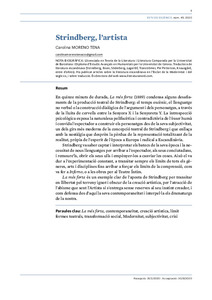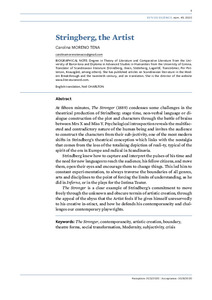| dc.contributor.author | Moreno Tena, Carolina | |
| dc.date.accessioned | 2021-01-28T08:37:35Z | |
| dc.date.available | 2021-01-28T08:37:35Z | |
| dc.date.issued | 2020 | |
| dc.identifier.issn | 2385-362X | |
| dc.identifier.issn | 0212-3819 | |
| dc.identifier.uri | http://hdl.handle.net/20.500.11904/1174 | |
| dc.description.abstract | <p>At fifteen minutes, <em>The Stronger </em>(1889) condenses some challenges in the theatrical production of Strindberg: stage time, non-verbal language or dialogue construction of the plot and characters through the battle of brains between Mrs X and Miss Y. Psychological introspection reveals the multifaceted and contradictory nature of the human being and invites the audience to construct the characters from their sub-jectivity, one of the most modern shifts in Strindberg's theatrical conception which links with the nostalgia that comes from the loss of the totalising depiction of reali-ty, typical of the spirit of the era in Europe and radical in Scandinavia.</p>
<p>Strindberg knew how to capture and interpret the pulses of his time and the need for new languages to reach the audience, his fellow citizens, and move them, open their eyes and encourage them to change things. This led him to constant experi-mentation, to always traverse the boundaries of all genres, arts and disciplines to the point of forcing the limits of understanding, as he did in <em>Inferno</em>, or in the plays for the Intima Teater.</p>
<p><em>The Stronger </em>is a clear example of Strindberg's commitment to move freely through the unknown and obscure terrain of artistic creation, through the appeal of the abyss that the Artist feels if he gives himself unreservedly to his creative in-stinct, and how he defends his contemporaneity and challenges our contemporary playwrights.</p> | |
| dc.description.abstract | <p>En quinze minuts de durada, <em>La més forta </em>(1889) condensa alguns desafiaments de la producció teatral de Strindberg: el temps escènic, el llenguatge no verbal o la construcció dialògica de l'argument i dels personatges, a través de la lluita de cervells entre la Senyora X i la Senyoreta Y. La introspecció psicològica exposa la naturalesa polifacètica i contradictòria de l'ésser humà i convida l'espectador a construir els personatges des de la seva subjectivitat, un dels girs més moderns de la concepció teatral de Strindberg i que enllaça amb la nostàlgia que desprèn la pèrdua de la representació totalitzant de la realitat, pròpia de l'esperit de l'època a Europa i radical a Escandinàvia. Strindberg va saber captar i interpretar els batecs de la seva època i la necessitat de nous llenguatges per arribar a l'espectador, als seus conciutadans, i remoure’ls, obrir els seus ulls i empènyer-los a canviar les coses. Això el va dur a l’experimentació constant, a transitar sempre els límits de tots els gèneres, arts i disciplines fins arribar a forçar els límits de la comprensió, com va fer a <em>Inferno</em>, o a les obres per al Teatre Íntim.</p>
<p><em>La més forta </em>és un exemple clar de l'aposta de Strindberg per transitar en llibertat pel terreny ignot i obscur de la creació artística, per l'atracció de l'abisme que sent l'Artista si s'entrega sense reserves al seu instint creador, i com defensa des d'aquí la seva contemporaneïtat i interpel·la els dramaturgs de la nostra.</p> | |
| dc.relation.ispartof | Estudis escènics: quaderns de l'Institut del Teatre. 2020, Núm. 45 | |
| dc.title | Strindberg, l’artista | |
| dc.type | Article | |
| dc.date.updated | 2021-01-28T08:37:36Z | |
| dc.rights.access | Open Access | |



